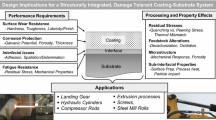Abstract
Tungsten carbide thermal spray coatings are important to the aerospace industry for the mitigation of midspan damper wear on jet engine fan and compressor blades. However, in some cases the coating can fail due to spallation and cracking, and in other situations the fatigue life of a fan or compressor blade is reduced when a coating is applied. Coating failures can result in decreased engine performance and costly maintenance time. A comprehensive experimental research program was conducted to evaluate coating crack resistance in bending, low-cycle fatigue properties of the coating and substrate, coating performance in jet engine tests, and microstructures for a wide range of coating compositions and application processes. Coating residual stress distributions also were evaluated. Eleven coatings were ranked according to their performance relative to the other coatings in each evaluation category. Results from the bend and low-cycle fatigue evaluations were compared to the experimentally evaluated residual stresses. Comparisons of rankings indicate a strong correlation between performance and the residual stresses in the coatings. Results from the program were used to select a suitable coating system for final in-service use based on two important criteria: (1) the coating must not fail while in service, and (2) the coating must not induce crack propagation into the substrate of the midspan damper.
Similar content being viewed by others
References
M. Gudge, D.S. Rickerby, K.T. Kingswell, and T. Scott, Residual Stress in Plasma Metallic and Ceramic Coatings,Thermal Spray Research and Applications, T.F. Bernecki, Ed., ASM International, 1991, p 331– 337
T. Morishita, R.W. Whitfield, E. Kuramochi, and S. Tanabe, Coatings with Compressive Stress,Thermal Spray: International Advances in Coatings Technology, C.C. Berndt, Ed., ASM International, 1992, p 1001–1004
S. Kuroda, T. Fukushima, and S. Kitahara, Significance of the Quench- ing Stress in the Cohesion and Adhesion of Thermally Sprayed Coat- ings,Thermal Spray: International Advances in Coatings Technol- ogy, C.C. Berndt, Ed., ASM International, 1992, p 903–909
S. Tobe, S. Kodama, H. Misawa, and K. Ishikawa, Rolling Fatigue Be- havior of Plasma Sprayed Coatings on Aluminum Alloy,Thermal Spray Research and Applications, T.F. Bernecki, Ed., ASM Interna- tional, 1991, p 171–177
D.J. Greving, J.R. Shadley, and E.F. Rybicki, Effects of Coating Thick- ness and Residual Stresses on the Bond Strength of ASTM C633-79 Thermal Spray Coating Test Specimens,J. Therm. Spray Technol., Vol. 3 (No. 4), 1994, p 371–378
P.K. Sharp, J.Q. Clayton, and G. Clark, The Fatigue Resistance of Peened 7050-T7451 Aluminum Alloy—Repair and Re-Treatment of a Component Surface,Fatigue Fract. Eng. Mater. Struct., Vol 17 (No. 3), 1994, p 243–252
A.M. Hashem, and I.H. Aly, High-Cycle Fatigue Life of Coated Low- Carbon Steel,Fatigue, Vol 16, July 1994, p 321–326
J.U. Hwang, T. Ogawa, and K. Tokaji, Fatigue Strength and Fracture Mecha- nisms of Ceramic-Sprayed Steel in Air and a Corrosive Environment,Fa- tigue Fract. Eng. Mater. Struct., Vol 17 (No. 7), 1994, p 839–848
A.A. Rakitsky, E.R. De Los Rios, and K.J. Miller, Fatigue Resistance of a Medium Carbon Steel with a Wear Resistant Thermal Spray Coating,Fatigue Fract. Eng. Mater. Struct., Vol 17(No. 5), 1994, p 563–570
D.J. Greving, E.F. Rybicki, and J.R. Shadley, Through-Thickness Re- sidual Stress Evaluations for Some Thermal Spray Coatings of Indus- trial Importance Using a Modified Layer Removal Method,J. Therm. Spray Technol., Vol 3 (No. 4), 1994, p 379–388
“Standard Practice for Conducting Constant Amplitude Axial Fatigue Tests of Metallic Materials,” E466-82,Annual Book ofASTM Stand- ards, Vol 3.01, ASTM, 1993, p 567–571
S. Takeuchi, M. Ito, and K. Takeda, Modeling of Residual Stress in Plasma-Sprayed Coatings: Effects of Substrate Temperature,Surf. Coat. Technol., Vol 43/44 (No. 1-3), 1990, p 426–435
Author information
Authors and Affiliations
Rights and permissions
About this article
Cite this article
Pejryd, L., Wigren, J., Greving, D.J. et al. Residual stresses as a factor in the selection of tungsten carbide coatings for a jet engine application. JTST 4, 268–274 (1995). https://doi.org/10.1007/BF02646970
Issue Date:
DOI: https://doi.org/10.1007/BF02646970




